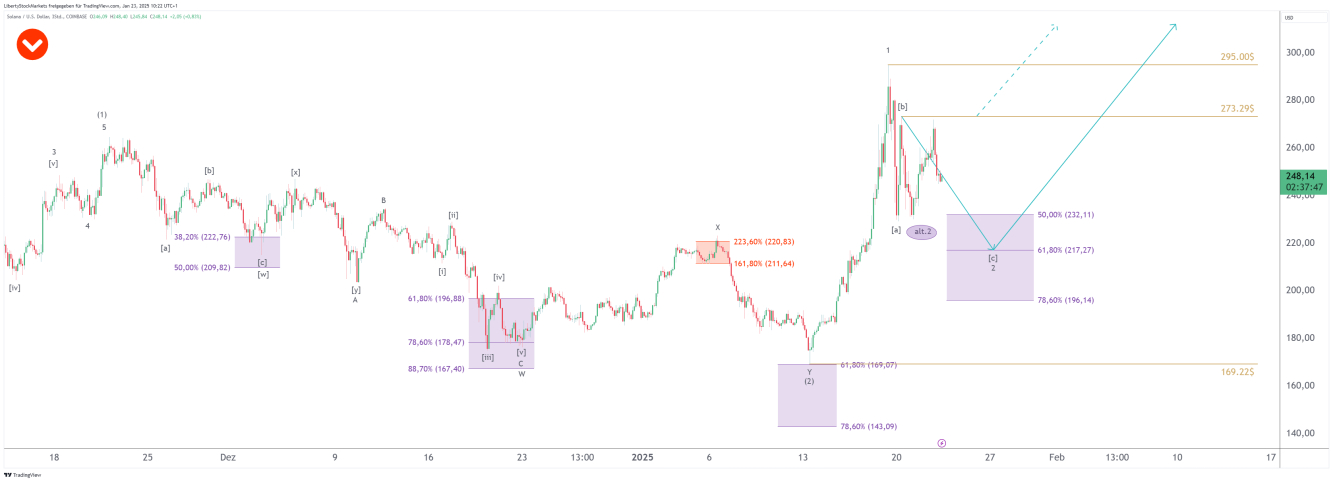Solana users on Coinbase (NASDAQ:COIN) are currently experiencing difficulties, particularly due to the rush of investors attracted by the new memecoins $TRUMP and $MELANIA. This high demand has led to transaction problems for many users, with some even unable to send assets for hours.
Is Solana a buy now?
If we look at the chart, there are two possibilities. Either the coin breaks out above $273.29, in which case the small correction is already over. Or the coin finally slips down into the purple box at $232.11 to $196.14, with $217.27 as the ideal target.

In the long term, however, the coin is worth buying either way, because we expect the price to rise sharply over the coming months or even years.
Technical challenges of the blockchain or other problems?
These difficulties are often attributed to the Solana blockchain, as similar incidents have occurred in the past. Due to the meme coins, more than 70% of transactions were canceled, which severely affected the efficiency of the blockchain.
Although the error rate has since been reduced to about 20%, these problems continue to pose a challenge. In addition, there is a bottleneck caused by the limited bandwidth of the validators of only 0.8 Gbps. However, this is expected to increase to up to 100 Gbps with the use of InfiniSVM.
New scaling solutions like Solaxy aim to further improve the efficiency of Solana to better prepare the blockchain for increasing demand and the age of mass adoption. This era seems to have dawned with the inauguration of Donald Trump and the introduction of his own memecoins and crypto-friendly policies.
Solaxy is working on a sidechain that is supposed to be even more efficient than Solana and is building a bridge to Ethereum to enable developers, users and investors to choose the optimal blockchain. This will create a combination of two of the leading blockchain ecosystems.
This innovative approach has already resulted in Solaxy raising $12.66 million in pre-sales in just one month. Coins are currently on sale at a discount of $0.001608 with a 297% staking yield. However, a price increase is imminent.
Transaction issues were not due to Solana this time
The recent Solana transaction issues have caused a stir in the crypto community. While some blamed the blockchain, others blamed Coinbase.
A well-known crypto investor, Ansem, announced on X that he would leave Coinbase until the transaction problems with Solana were resolved. Other users also reported transactions that had not been processed after 16 hours.
Such problems can be particularly frustrating for emotionally reactive traders who are waiting for an important trading opportunity but cannot access it. Especially in relation to the Memecoins, Solana has become the leading blockchain, which is why the functionality of the blockchain is important for the high volume of transactions on the DEXs.
Nevertheless, this incident had no negative impact on Coinbase's share price. On the contrary, the stock rose by almost 8% yesterday, which may be due, among other things, to Donald Trump taking office. As the leading crypto exchange in the US, Coinbase could benefit particularly from the ‘America First’ agenda.
Merz Mumtaz, CEO of blockchain infrastructure company Helius Labs, explained that the transaction errors were not due to Solana itself. Instead, the indexing process on Coinbase was the trigger, which could be resolved by switching to the faster gRPC protocol.
Brian Armstrong, CEO of Coinbase, also commented on the problems and stated that his team was already working on a solution after the unexpectedly high activity occurred. You can find more about Coinbase and Solana on our YouTube channel and, of course, on our website.
Disclaimer/Risk warning:
The information provided here is for informational purposes only and does not constitute a recommendation to buy or sell. It should not be understood as an explicit or implicit assurance of a particular price development of the financial instruments mentioned or as a call to action. The purchase of securities involves risks that may lead to the total loss of the capital invested. The information provided does not replace expert investment advice tailored to individual needs. No liability or guarantee is assumed, either explicitly or implicitly, for the timeliness, accuracy, appropriateness or completeness of the information provided, nor for any financial losses. These are expressly not financial analyses, but journalistic texts. Readers who make investment decisions or carry out transactions based on the information provided here do so entirely at their own risk. The authors may hold securities of the companies/securities/shares discussed at the time of publication and therefore a conflict of interest may exist.
Which stock should you buy in your very next trade?
With valuations skyrocketing in 2024, many investors are uneasy putting more money into stocks. Unsure where to invest next? Get access to our proven portfolios and discover high-potential opportunities.
In 2024 alone, ProPicks AI identified 2 stocks that surged over 150%, 4 additional stocks that leaped over 30%, and 3 more that climbed over 25%. That's an impressive track record.
With portfolios tailored for Dow stocks, S&P stocks, Tech stocks, and Mid Cap stocks, you can explore various wealth-building strategies.
